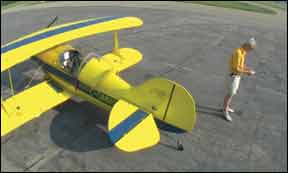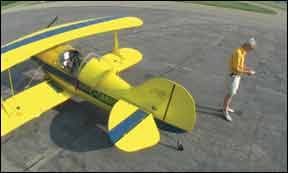Pilots of personal aircraft ultimately have all the responsibility to ensure a flight is conducted safely. To help meet our responsibilities to ourselves and our passengers, we need to minimize the outside world’s distractions when we sit down in the cockpit to focus on the task at hand. Different pilots have different ways of focusing, but one common thread is blocking out anything unrelated to ensuring the upcoming flight’s success. That’s a major challenge when we serve as baggage handler, dispatcher, meteorologist and pilot.

288
It’s also a major challenge in the dynamic world of air show pilots. An air show’s sights, sounds and attention-grabbing activities perhaps make it one of the worst places a pilot can be prior to a flight. But pilots about to fly their air show routines have implemented a formal “quiet time,” allowing them to focus on their upcoming flight and get into “the zone” or “the game,” if you will. Here’s how they do it.
The “Sacred 60”
Prior to flying their routines, air show performers must attend to their aircraft, get to and from briefings, obtain food and fluids, constantly monitor the air boss frequency for schedule or order changes, give media interviews, and deal with many other distractions. And, after all of this, they must safely fly demanding routines in confined airspace in front of tens of thousands of people at an unfamiliar airport.
Even if your next flight doesn’t involve flying upside down 20 feet off the deck or doing a ribbon cut on knife-edge, you might face circumstances that are every bit as chaotic. You need fuel and fluids. Your IFR clearance void time might be approaching. Passengers don’t show up on time or they require assistance for which you hadn’t planned. Advancing weather sometimes adds pressure to launch earlier than expected. And the rest of the world (usually in the form of your smartphone) continues to make demands on you that have little or nothing to do with keeping an aircraft right-side-up and pointed in the right direction.
Distraction, fatigue and stress can threaten any pilot and any mission. Air show pilots deal with these issues by observing the “Sacred 60 Minutes.” The Sacred 60 is exactly what it sounds like it might be. It’s an uninterrupted, undistracted, sacrosanct period of time before you step to the aircraft during which you relax, focus and separate yourself from anything unrelated to the flight, and mentally prepare for conducting the flight safely.
What The FAA Says
The FAA characterizes pilots’ states of mind prior to flying in several ways, mostly in the context of aeromedical factors and aeronautical decision making (“ADM”). The FAA points out in the Pilot’s Handbook of Aeronautical Knowledge (FAA-H-8083-25A) that stress, including “physical stress (noise or vibration), physiological stress (fatigue), and psychological stress (difficult work or personal situations)” can degrade performance. Further, “[f]atigue is frequently associated with pilot error. Some of the effects of fatigue include degradation of attention and concentration, impaired coordination, and decreased ability to communicate.”
The FAA addresses fatigue, stress and similar issues almost entirely in the context of go/no-go decisions. For example, most pilots are familiar with the FAA’s recommended “IMSAFE” (Illness, Medication, Stress Alcohol, Fatigue and Eating) checklist. Stress and fatigue are well-represented in that checklist. The FAA’s “PAVE” (Pilot, Aircraft, enVironment and External pressures) checklist goes even further into those stressors by acknowledging the range of “influences external to the flight that create a sense of pressure to complete a flight—often at the expense of safety.” Demanding passengers, the desire to impress, “get-there-itis,” job pressures, money trouble, family problems, stubborn pride and other factors all come into play.
Certainly, a squawk on the IMSAFE or PAVE checklist should scrub the flight (or at least the pilot). But there’s little in the FAA’s literature addressing situations in which the pilot is “go,” but a transition period could improve the pilot’s mental state and make the flight safer. After all, it is the rare pilot indeed who is completely free of those stressors. Even a “go” decision is usually a result of acknowledging that these stressors exist but deciding that they are not so large as to adversely affect safety of flight. The Sacred 60 helps to fill the gap between mere “go” and full proficiency and capability.
A Full Hour?
Although we’re referring to a “Sacred 60 Minutes,” your pre-flight quiet time need not be 60 minutes long. The right amount of time is whatever allows you to achieve adequate mental distance from the other things competing for your attention and to focus on the flight. That said, just like any other personal minima, pick a specific minimum amount of time and stick with it. You can always go longer if you need to. Don’t go shorter. Even if you run out of things to brief or think about, there’s a lot to be said for just holding still with a quiet mind.
Explain to your passengers, fellow pilots and anyone else at the airport who might distract you that you want to reserve some quiet time to yourself before getting into the aircraft. It helps to ask if they have any questions or needs right before you withdraw. Giving those people an opportunity to speak or hold their peace makes them participants in your process and draws a line that will let you have some distance while you focus.
Don’t forget to account for people who are not at the airport, but who still might distract you. Tell people that you’ll be flying and unavailable for a time. If you have to tell them what time, give them the time at which you’ll start your Sacred 60, not the time you plan to be wheels-up. Then shut off your mobile device when you begin your Sacred 60. Or at least put it in “airplane mode.” (This is probably not what the designers had in mind when they named that mode, but it’s very appropriate in this context anyway.) You can always turn it back on and check it just before you step to the aircraft. But chances are that you won’t want to.
Do whatever you need to do to separate yourself from anything not bearing directly on the flight. If music helps, plug in your earbuds. If walking helps, walk. Some pilots talk to their aircraft. Some hum. Some recite checklists. Ritual is extremely powerful. Use it. Try to do the same things every time. Whatever you do, it should be different from what you do when you’re not about to fly an aircraft. That “differentness” helps to reinforce that this is special time with a special purpose.
If you’re comfortable doing so, you can include briefing the flight with other aircrew in your version of the Sacred 60. But treat the briefing just as you would a sterile cockpit and speak of nothing but the flight. Unrelated conversation is a distraction just like the ones that you’re trying to avoid with the Sacred 60 in the first place. Start any such briefing with a declaration that you’re in the Sacred 60 and that you’re maintaining that virtual “sterile cockpit.”
Finding Focus
Every pilot knows external pressures can adversely affect his or her ability to operate at full potential. Even if pilots couldn’t figure that out for themselves, the FAA’s research shows that distractions, stress and fatigue degrade performance and lead to increased risk. Air show pilots deal with those conditions constantly and they do so in one of the most demanding flight environments to be found in peacetime. The air show industry has recognized the danger of distraction and stress, and institutionalized the Sacred 60 Minutes as a means of reducing distraction, improving focus and contributing to the safety of its operations.
You don’t have to be an air show pilot to need air show-strength tools to deal with distraction and stress. Adapting the Sacred 60 to your operations by adding interruption-free time prior to your flights can help you focus and fly safely.
Steve Tupper is an attorney and commercial pilot who covered air shows for six years for the Airspeed podcast (www.airspeedonline.com) before becoming an air show pilot himself in 2012. He also flies competition aerobatics and is a mission pilot for the Civil Air Patrol.




